Working in Teams: Qualities, Leadership, Motivation, Delegation, Influencing, Interpersonal Relationships, Conflict Resolution
VerifiedAdded on 2023/06/18
|12
|3233
|336
AI Summary
This report covers the qualities of an effective team, skills required for an effective team leader, different theories of motivation, benefits and risks of delegation, importance of interpersonal relationships, and approaches to resolve conflicts in work teams.
Contribute Materials
Your contribution can guide someone’s learning journey. Share your
documents today.
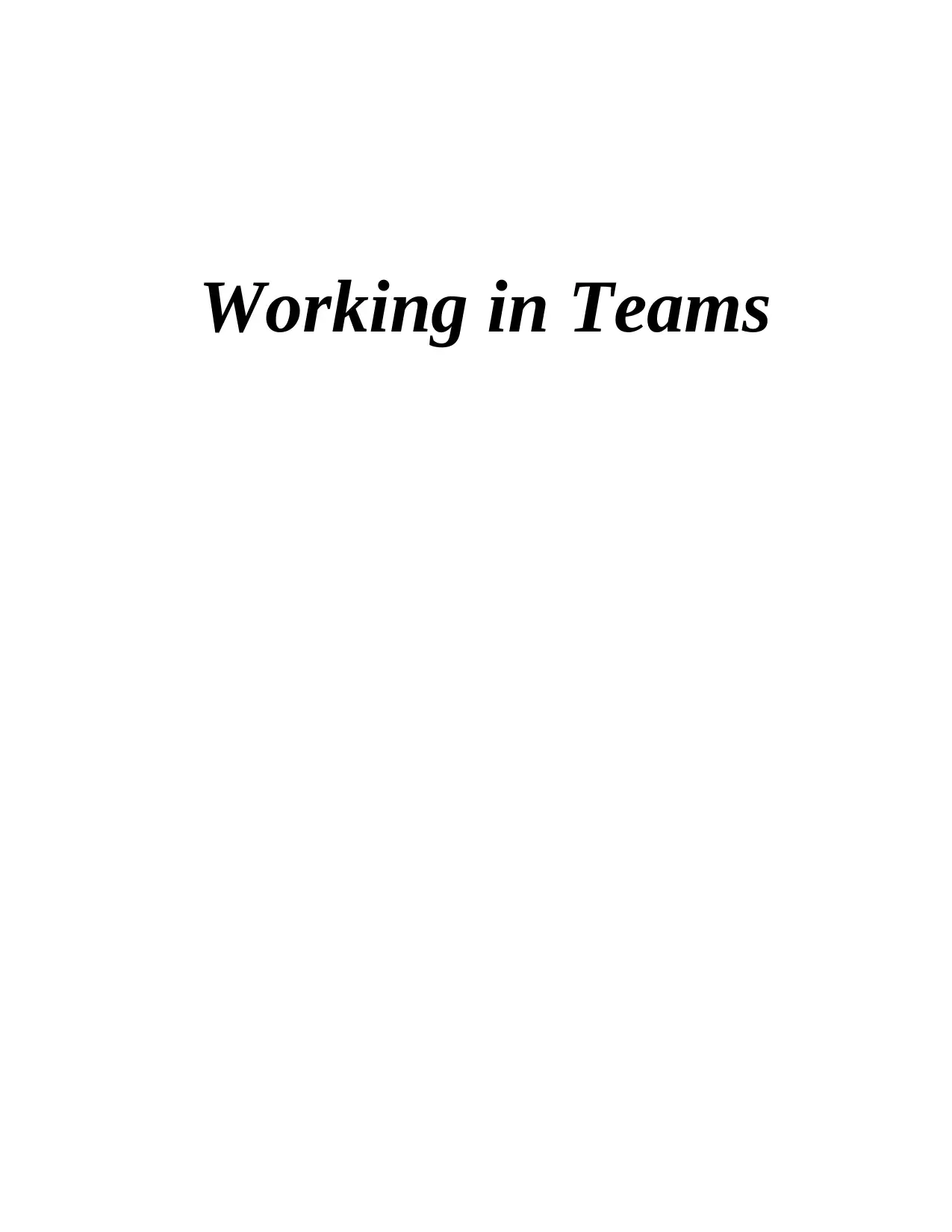
Working in Teams
Secure Best Marks with AI Grader
Need help grading? Try our AI Grader for instant feedback on your assignments.
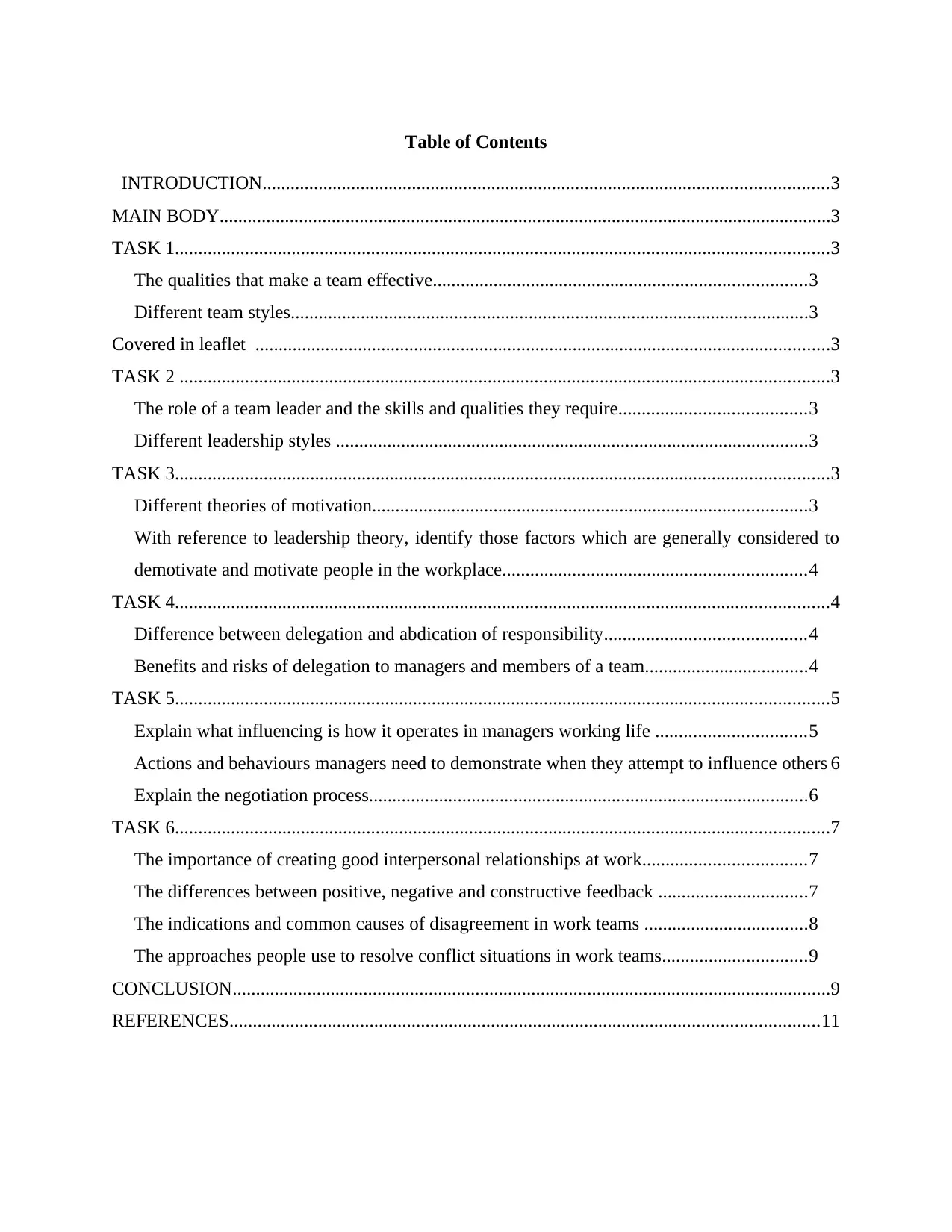
Table of Contents
INTRODUCTION.........................................................................................................................3
MAIN BODY...................................................................................................................................3
TASK 1............................................................................................................................................3
The qualities that make a team effective................................................................................3
Different team styles...............................................................................................................3
Covered in leaflet ...........................................................................................................................3
TASK 2 ...........................................................................................................................................3
The role of a team leader and the skills and qualities they require........................................3
Different leadership styles .....................................................................................................3
TASK 3............................................................................................................................................3
Different theories of motivation.............................................................................................3
With reference to leadership theory, identify those factors which are generally considered to
demotivate and motivate people in the workplace.................................................................4
TASK 4............................................................................................................................................4
Difference between delegation and abdication of responsibility...........................................4
Benefits and risks of delegation to managers and members of a team...................................4
TASK 5............................................................................................................................................5
Explain what influencing is how it operates in managers working life ................................5
Actions and behaviours managers need to demonstrate when they attempt to influence others 6
Explain the negotiation process..............................................................................................6
TASK 6............................................................................................................................................7
The importance of creating good interpersonal relationships at work...................................7
The differences between positive, negative and constructive feedback ................................7
The indications and common causes of disagreement in work teams ...................................8
The approaches people use to resolve conflict situations in work teams...............................9
CONCLUSION................................................................................................................................9
REFERENCES..............................................................................................................................11
INTRODUCTION.........................................................................................................................3
MAIN BODY...................................................................................................................................3
TASK 1............................................................................................................................................3
The qualities that make a team effective................................................................................3
Different team styles...............................................................................................................3
Covered in leaflet ...........................................................................................................................3
TASK 2 ...........................................................................................................................................3
The role of a team leader and the skills and qualities they require........................................3
Different leadership styles .....................................................................................................3
TASK 3............................................................................................................................................3
Different theories of motivation.............................................................................................3
With reference to leadership theory, identify those factors which are generally considered to
demotivate and motivate people in the workplace.................................................................4
TASK 4............................................................................................................................................4
Difference between delegation and abdication of responsibility...........................................4
Benefits and risks of delegation to managers and members of a team...................................4
TASK 5............................................................................................................................................5
Explain what influencing is how it operates in managers working life ................................5
Actions and behaviours managers need to demonstrate when they attempt to influence others 6
Explain the negotiation process..............................................................................................6
TASK 6............................................................................................................................................7
The importance of creating good interpersonal relationships at work...................................7
The differences between positive, negative and constructive feedback ................................7
The indications and common causes of disagreement in work teams ...................................8
The approaches people use to resolve conflict situations in work teams...............................9
CONCLUSION................................................................................................................................9
REFERENCES..............................................................................................................................11
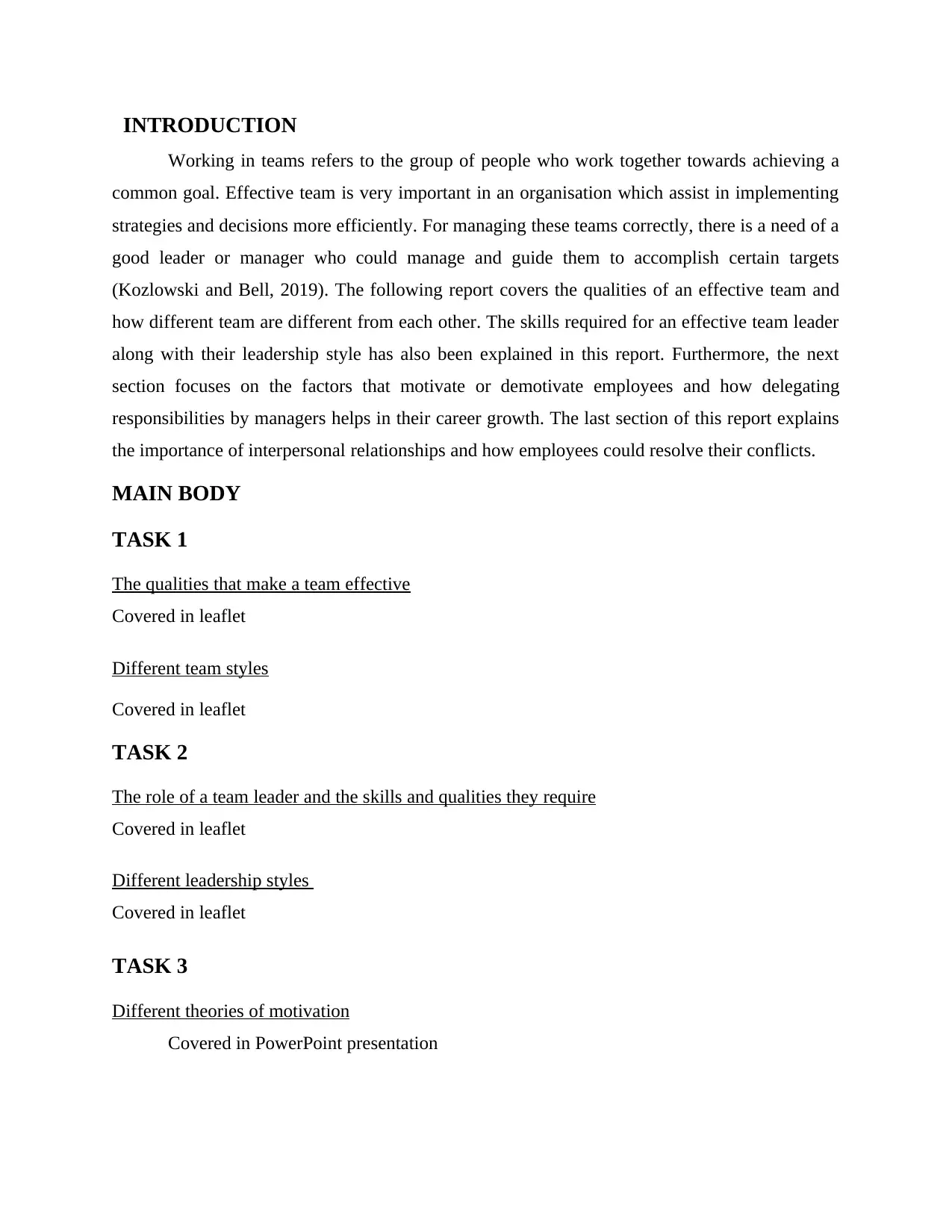
INTRODUCTION
Working in teams refers to the group of people who work together towards achieving a
common goal. Effective team is very important in an organisation which assist in implementing
strategies and decisions more efficiently. For managing these teams correctly, there is a need of a
good leader or manager who could manage and guide them to accomplish certain targets
(Kozlowski and Bell, 2019). The following report covers the qualities of an effective team and
how different team are different from each other. The skills required for an effective team leader
along with their leadership style has also been explained in this report. Furthermore, the next
section focuses on the factors that motivate or demotivate employees and how delegating
responsibilities by managers helps in their career growth. The last section of this report explains
the importance of interpersonal relationships and how employees could resolve their conflicts.
MAIN BODY
TASK 1
The qualities that make a team effective
Covered in leaflet
Different team styles
Covered in leaflet
TASK 2
The role of a team leader and the skills and qualities they require
Covered in leaflet
Different leadership styles
Covered in leaflet
TASK 3
Different theories of motivation
Covered in PowerPoint presentation
Working in teams refers to the group of people who work together towards achieving a
common goal. Effective team is very important in an organisation which assist in implementing
strategies and decisions more efficiently. For managing these teams correctly, there is a need of a
good leader or manager who could manage and guide them to accomplish certain targets
(Kozlowski and Bell, 2019). The following report covers the qualities of an effective team and
how different team are different from each other. The skills required for an effective team leader
along with their leadership style has also been explained in this report. Furthermore, the next
section focuses on the factors that motivate or demotivate employees and how delegating
responsibilities by managers helps in their career growth. The last section of this report explains
the importance of interpersonal relationships and how employees could resolve their conflicts.
MAIN BODY
TASK 1
The qualities that make a team effective
Covered in leaflet
Different team styles
Covered in leaflet
TASK 2
The role of a team leader and the skills and qualities they require
Covered in leaflet
Different leadership styles
Covered in leaflet
TASK 3
Different theories of motivation
Covered in PowerPoint presentation
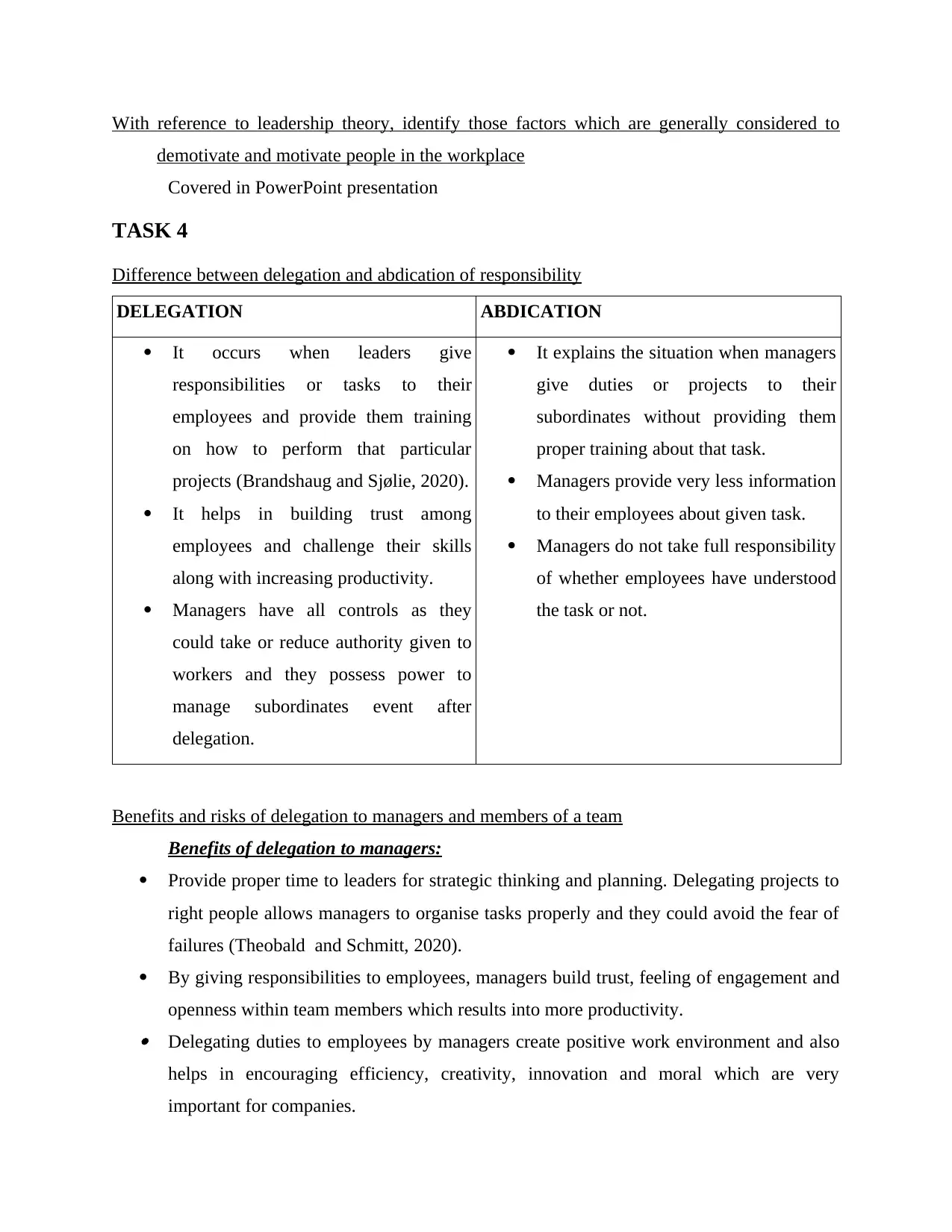
With reference to leadership theory, identify those factors which are generally considered to
demotivate and motivate people in the workplace
Covered in PowerPoint presentation
TASK 4
Difference between delegation and abdication of responsibility
DELEGATION ABDICATION
It occurs when leaders give
responsibilities or tasks to their
employees and provide them training
on how to perform that particular
projects (Brandshaug and Sjølie, 2020).
It helps in building trust among
employees and challenge their skills
along with increasing productivity.
Managers have all controls as they
could take or reduce authority given to
workers and they possess power to
manage subordinates event after
delegation.
It explains the situation when managers
give duties or projects to their
subordinates without providing them
proper training about that task.
Managers provide very less information
to their employees about given task.
Managers do not take full responsibility
of whether employees have understood
the task or not.
Benefits and risks of delegation to managers and members of a team
Benefits of delegation to managers:
Provide proper time to leaders for strategic thinking and planning. Delegating projects to
right people allows managers to organise tasks properly and they could avoid the fear of
failures (Theobald and Schmitt, 2020).
By giving responsibilities to employees, managers build trust, feeling of engagement and
openness within team members which results into more productivity. Delegating duties to employees by managers create positive work environment and also
helps in encouraging efficiency, creativity, innovation and moral which are very
important for companies.
demotivate and motivate people in the workplace
Covered in PowerPoint presentation
TASK 4
Difference between delegation and abdication of responsibility
DELEGATION ABDICATION
It occurs when leaders give
responsibilities or tasks to their
employees and provide them training
on how to perform that particular
projects (Brandshaug and Sjølie, 2020).
It helps in building trust among
employees and challenge their skills
along with increasing productivity.
Managers have all controls as they
could take or reduce authority given to
workers and they possess power to
manage subordinates event after
delegation.
It explains the situation when managers
give duties or projects to their
subordinates without providing them
proper training about that task.
Managers provide very less information
to their employees about given task.
Managers do not take full responsibility
of whether employees have understood
the task or not.
Benefits and risks of delegation to managers and members of a team
Benefits of delegation to managers:
Provide proper time to leaders for strategic thinking and planning. Delegating projects to
right people allows managers to organise tasks properly and they could avoid the fear of
failures (Theobald and Schmitt, 2020).
By giving responsibilities to employees, managers build trust, feeling of engagement and
openness within team members which results into more productivity. Delegating duties to employees by managers create positive work environment and also
helps in encouraging efficiency, creativity, innovation and moral which are very
important for companies.
Secure Best Marks with AI Grader
Need help grading? Try our AI Grader for instant feedback on your assignments.
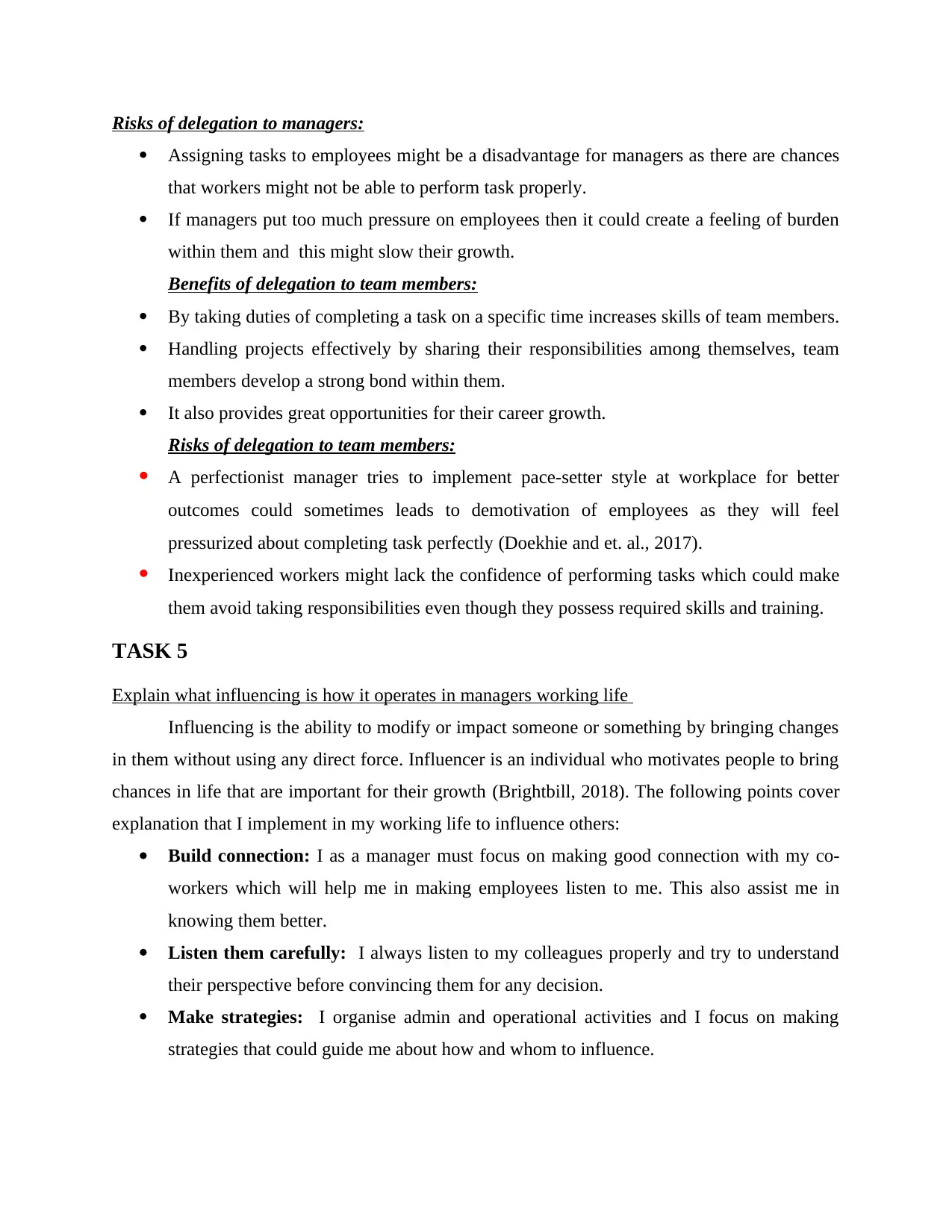
Risks of delegation to managers:
Assigning tasks to employees might be a disadvantage for managers as there are chances
that workers might not be able to perform task properly.
If managers put too much pressure on employees then it could create a feeling of burden
within them and this might slow their growth.
Benefits of delegation to team members:
By taking duties of completing a task on a specific time increases skills of team members.
Handling projects effectively by sharing their responsibilities among themselves, team
members develop a strong bond within them.
It also provides great opportunities for their career growth.
Risks of delegation to team members:
A perfectionist manager tries to implement pace-setter style at workplace for better
outcomes could sometimes leads to demotivation of employees as they will feel
pressurized about completing task perfectly (Doekhie and et. al., 2017).
Inexperienced workers might lack the confidence of performing tasks which could make
them avoid taking responsibilities even though they possess required skills and training.
TASK 5
Explain what influencing is how it operates in managers working life
Influencing is the ability to modify or impact someone or something by bringing changes
in them without using any direct force. Influencer is an individual who motivates people to bring
chances in life that are important for their growth (Brightbill, 2018). The following points cover
explanation that I implement in my working life to influence others:
Build connection: I as a manager must focus on making good connection with my co-
workers which will help me in making employees listen to me. This also assist me in
knowing them better.
Listen them carefully: I always listen to my colleagues properly and try to understand
their perspective before convincing them for any decision.
Make strategies: I organise admin and operational activities and I focus on making
strategies that could guide me about how and whom to influence.
Assigning tasks to employees might be a disadvantage for managers as there are chances
that workers might not be able to perform task properly.
If managers put too much pressure on employees then it could create a feeling of burden
within them and this might slow their growth.
Benefits of delegation to team members:
By taking duties of completing a task on a specific time increases skills of team members.
Handling projects effectively by sharing their responsibilities among themselves, team
members develop a strong bond within them.
It also provides great opportunities for their career growth.
Risks of delegation to team members:
A perfectionist manager tries to implement pace-setter style at workplace for better
outcomes could sometimes leads to demotivation of employees as they will feel
pressurized about completing task perfectly (Doekhie and et. al., 2017).
Inexperienced workers might lack the confidence of performing tasks which could make
them avoid taking responsibilities even though they possess required skills and training.
TASK 5
Explain what influencing is how it operates in managers working life
Influencing is the ability to modify or impact someone or something by bringing changes
in them without using any direct force. Influencer is an individual who motivates people to bring
chances in life that are important for their growth (Brightbill, 2018). The following points cover
explanation that I implement in my working life to influence others:
Build connection: I as a manager must focus on making good connection with my co-
workers which will help me in making employees listen to me. This also assist me in
knowing them better.
Listen them carefully: I always listen to my colleagues properly and try to understand
their perspective before convincing them for any decision.
Make strategies: I organise admin and operational activities and I focus on making
strategies that could guide me about how and whom to influence.
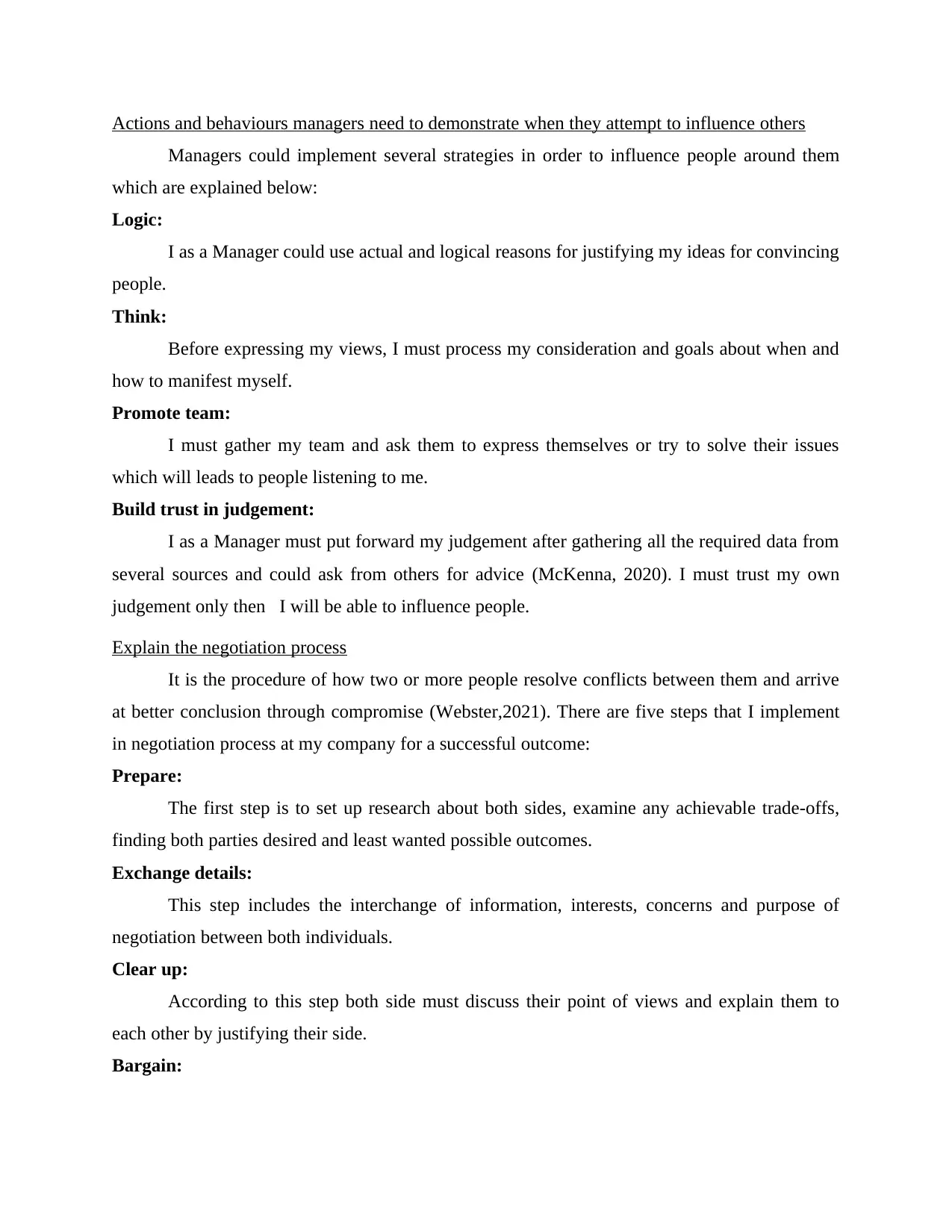
Actions and behaviours managers need to demonstrate when they attempt to influence others
Managers could implement several strategies in order to influence people around them
which are explained below:
Logic:
I as a Manager could use actual and logical reasons for justifying my ideas for convincing
people.
Think:
Before expressing my views, I must process my consideration and goals about when and
how to manifest myself.
Promote team:
I must gather my team and ask them to express themselves or try to solve their issues
which will leads to people listening to me.
Build trust in judgement:
I as a Manager must put forward my judgement after gathering all the required data from
several sources and could ask from others for advice (McKenna, 2020). I must trust my own
judgement only then I will be able to influence people.
Explain the negotiation process
It is the procedure of how two or more people resolve conflicts between them and arrive
at better conclusion through compromise (Webster,2021). There are five steps that I implement
in negotiation process at my company for a successful outcome:
Prepare:
The first step is to set up research about both sides, examine any achievable trade-offs,
finding both parties desired and least wanted possible outcomes.
Exchange details:
This step includes the interchange of information, interests, concerns and purpose of
negotiation between both individuals.
Clear up:
According to this step both side must discuss their point of views and explain them to
each other by justifying their side.
Bargain:
Managers could implement several strategies in order to influence people around them
which are explained below:
Logic:
I as a Manager could use actual and logical reasons for justifying my ideas for convincing
people.
Think:
Before expressing my views, I must process my consideration and goals about when and
how to manifest myself.
Promote team:
I must gather my team and ask them to express themselves or try to solve their issues
which will leads to people listening to me.
Build trust in judgement:
I as a Manager must put forward my judgement after gathering all the required data from
several sources and could ask from others for advice (McKenna, 2020). I must trust my own
judgement only then I will be able to influence people.
Explain the negotiation process
It is the procedure of how two or more people resolve conflicts between them and arrive
at better conclusion through compromise (Webster,2021). There are five steps that I implement
in negotiation process at my company for a successful outcome:
Prepare:
The first step is to set up research about both sides, examine any achievable trade-offs,
finding both parties desired and least wanted possible outcomes.
Exchange details:
This step includes the interchange of information, interests, concerns and purpose of
negotiation between both individuals.
Clear up:
According to this step both side must discuss their point of views and explain them to
each other by justifying their side.
Bargain:
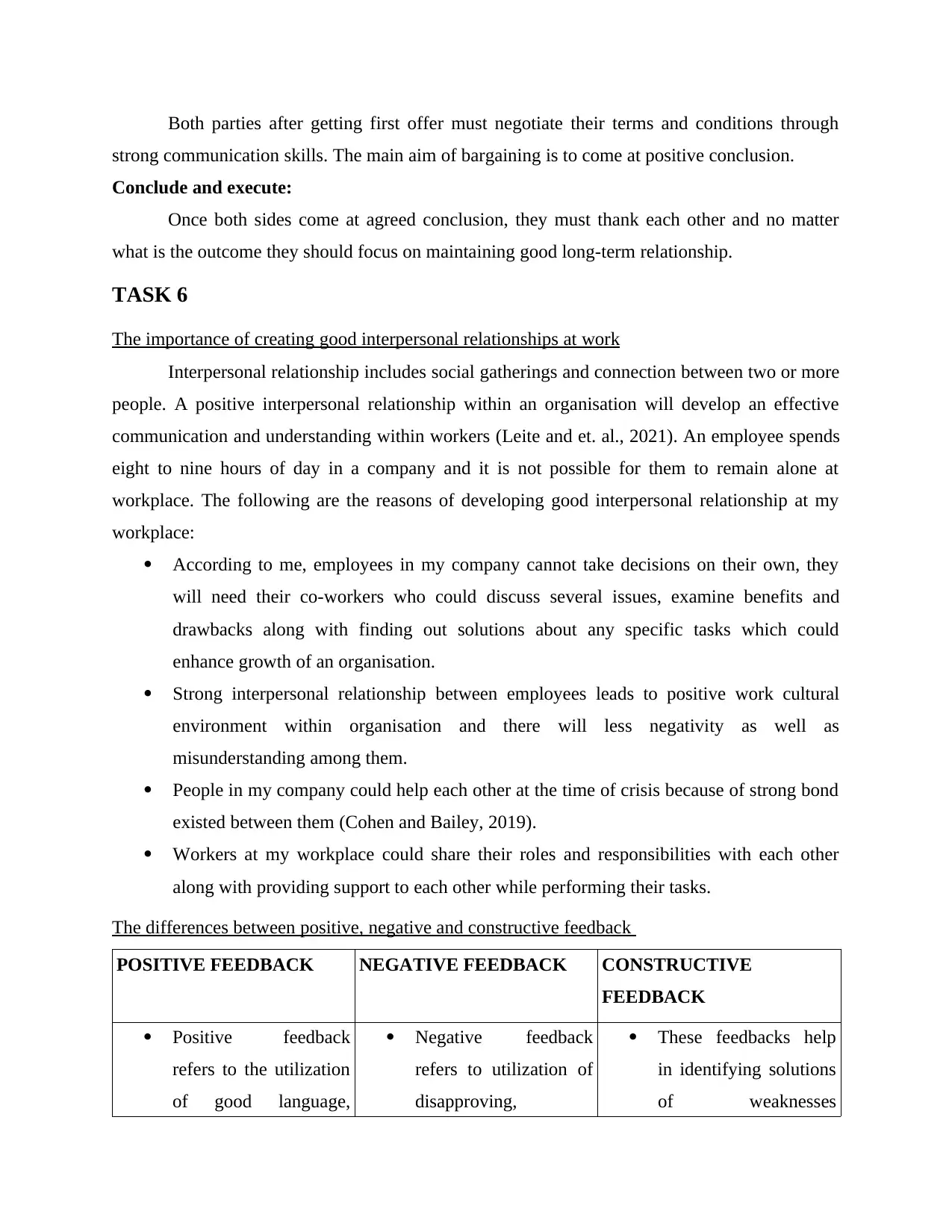
Both parties after getting first offer must negotiate their terms and conditions through
strong communication skills. The main aim of bargaining is to come at positive conclusion.
Conclude and execute:
Once both sides come at agreed conclusion, they must thank each other and no matter
what is the outcome they should focus on maintaining good long-term relationship.
TASK 6
The importance of creating good interpersonal relationships at work
Interpersonal relationship includes social gatherings and connection between two or more
people. A positive interpersonal relationship within an organisation will develop an effective
communication and understanding within workers (Leite and et. al., 2021). An employee spends
eight to nine hours of day in a company and it is not possible for them to remain alone at
workplace. The following are the reasons of developing good interpersonal relationship at my
workplace:
According to me, employees in my company cannot take decisions on their own, they
will need their co-workers who could discuss several issues, examine benefits and
drawbacks along with finding out solutions about any specific tasks which could
enhance growth of an organisation.
Strong interpersonal relationship between employees leads to positive work cultural
environment within organisation and there will less negativity as well as
misunderstanding among them.
People in my company could help each other at the time of crisis because of strong bond
existed between them (Cohen and Bailey, 2019).
Workers at my workplace could share their roles and responsibilities with each other
along with providing support to each other while performing their tasks.
The differences between positive, negative and constructive feedback
POSITIVE FEEDBACK NEGATIVE FEEDBACK CONSTRUCTIVE
FEEDBACK
Positive feedback
refers to the utilization
of good language,
Negative feedback
refers to utilization of
disapproving,
These feedbacks help
in identifying solutions
of weaknesses
strong communication skills. The main aim of bargaining is to come at positive conclusion.
Conclude and execute:
Once both sides come at agreed conclusion, they must thank each other and no matter
what is the outcome they should focus on maintaining good long-term relationship.
TASK 6
The importance of creating good interpersonal relationships at work
Interpersonal relationship includes social gatherings and connection between two or more
people. A positive interpersonal relationship within an organisation will develop an effective
communication and understanding within workers (Leite and et. al., 2021). An employee spends
eight to nine hours of day in a company and it is not possible for them to remain alone at
workplace. The following are the reasons of developing good interpersonal relationship at my
workplace:
According to me, employees in my company cannot take decisions on their own, they
will need their co-workers who could discuss several issues, examine benefits and
drawbacks along with finding out solutions about any specific tasks which could
enhance growth of an organisation.
Strong interpersonal relationship between employees leads to positive work cultural
environment within organisation and there will less negativity as well as
misunderstanding among them.
People in my company could help each other at the time of crisis because of strong bond
existed between them (Cohen and Bailey, 2019).
Workers at my workplace could share their roles and responsibilities with each other
along with providing support to each other while performing their tasks.
The differences between positive, negative and constructive feedback
POSITIVE FEEDBACK NEGATIVE FEEDBACK CONSTRUCTIVE
FEEDBACK
Positive feedback
refers to the utilization
of good language,
Negative feedback
refers to utilization of
disapproving,
These feedbacks help
in identifying solutions
of weaknesses
Paraphrase This Document
Need a fresh take? Get an instant paraphrase of this document with our AI Paraphraser
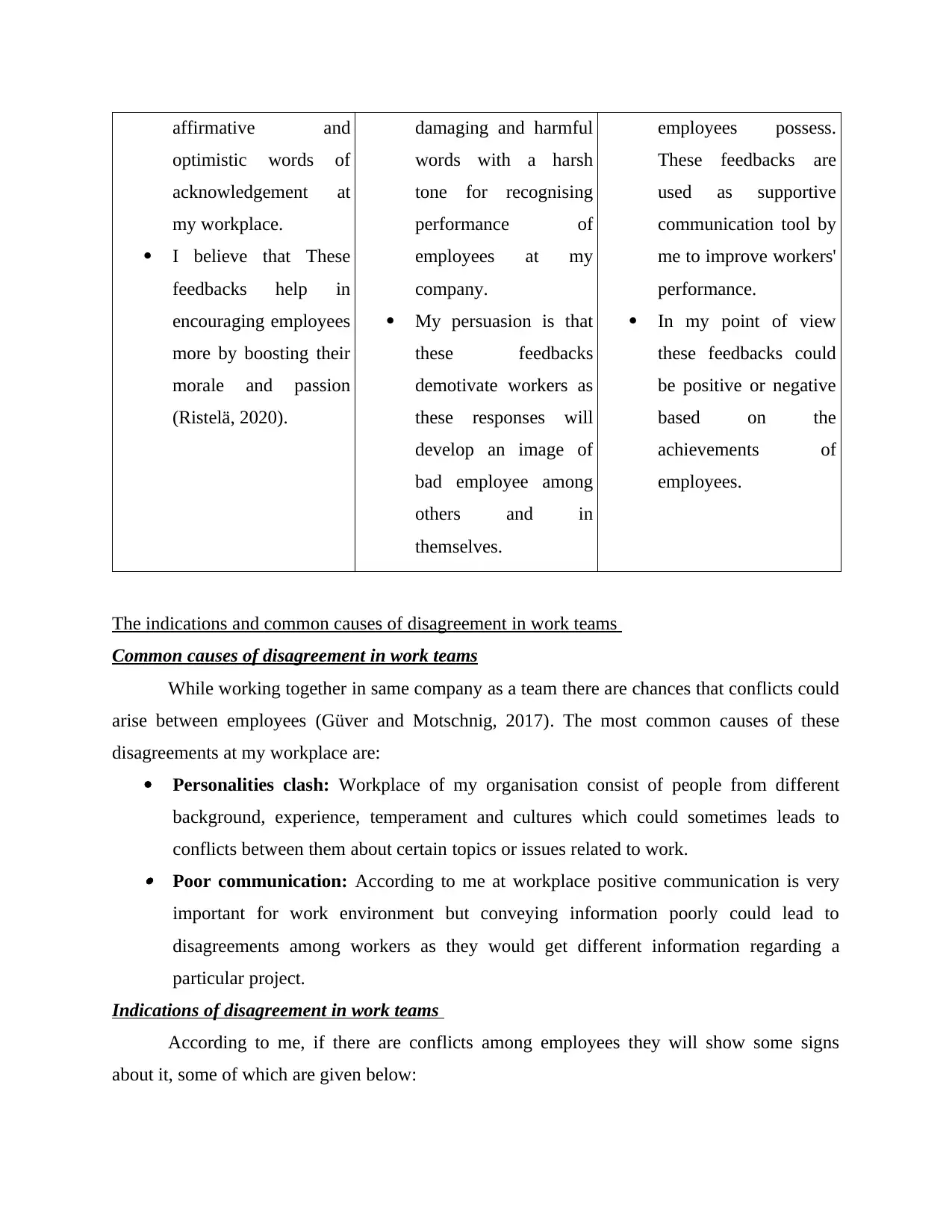
affirmative and
optimistic words of
acknowledgement at
my workplace.
I believe that These
feedbacks help in
encouraging employees
more by boosting their
morale and passion
(Ristelä, 2020).
damaging and harmful
words with a harsh
tone for recognising
performance of
employees at my
company.
My persuasion is that
these feedbacks
demotivate workers as
these responses will
develop an image of
bad employee among
others and in
themselves.
employees possess.
These feedbacks are
used as supportive
communication tool by
me to improve workers'
performance.
In my point of view
these feedbacks could
be positive or negative
based on the
achievements of
employees.
The indications and common causes of disagreement in work teams
Common causes of disagreement in work teams
While working together in same company as a team there are chances that conflicts could
arise between employees (Güver and Motschnig, 2017). The most common causes of these
disagreements at my workplace are:
Personalities clash: Workplace of my organisation consist of people from different
background, experience, temperament and cultures which could sometimes leads to
conflicts between them about certain topics or issues related to work. Poor communication: According to me at workplace positive communication is very
important for work environment but conveying information poorly could lead to
disagreements among workers as they would get different information regarding a
particular project.
Indications of disagreement in work teams
According to me, if there are conflicts among employees they will show some signs
about it, some of which are given below:
optimistic words of
acknowledgement at
my workplace.
I believe that These
feedbacks help in
encouraging employees
more by boosting their
morale and passion
(Ristelä, 2020).
damaging and harmful
words with a harsh
tone for recognising
performance of
employees at my
company.
My persuasion is that
these feedbacks
demotivate workers as
these responses will
develop an image of
bad employee among
others and in
themselves.
employees possess.
These feedbacks are
used as supportive
communication tool by
me to improve workers'
performance.
In my point of view
these feedbacks could
be positive or negative
based on the
achievements of
employees.
The indications and common causes of disagreement in work teams
Common causes of disagreement in work teams
While working together in same company as a team there are chances that conflicts could
arise between employees (Güver and Motschnig, 2017). The most common causes of these
disagreements at my workplace are:
Personalities clash: Workplace of my organisation consist of people from different
background, experience, temperament and cultures which could sometimes leads to
conflicts between them about certain topics or issues related to work. Poor communication: According to me at workplace positive communication is very
important for work environment but conveying information poorly could lead to
disagreements among workers as they would get different information regarding a
particular project.
Indications of disagreement in work teams
According to me, if there are conflicts among employees they will show some signs
about it, some of which are given below:
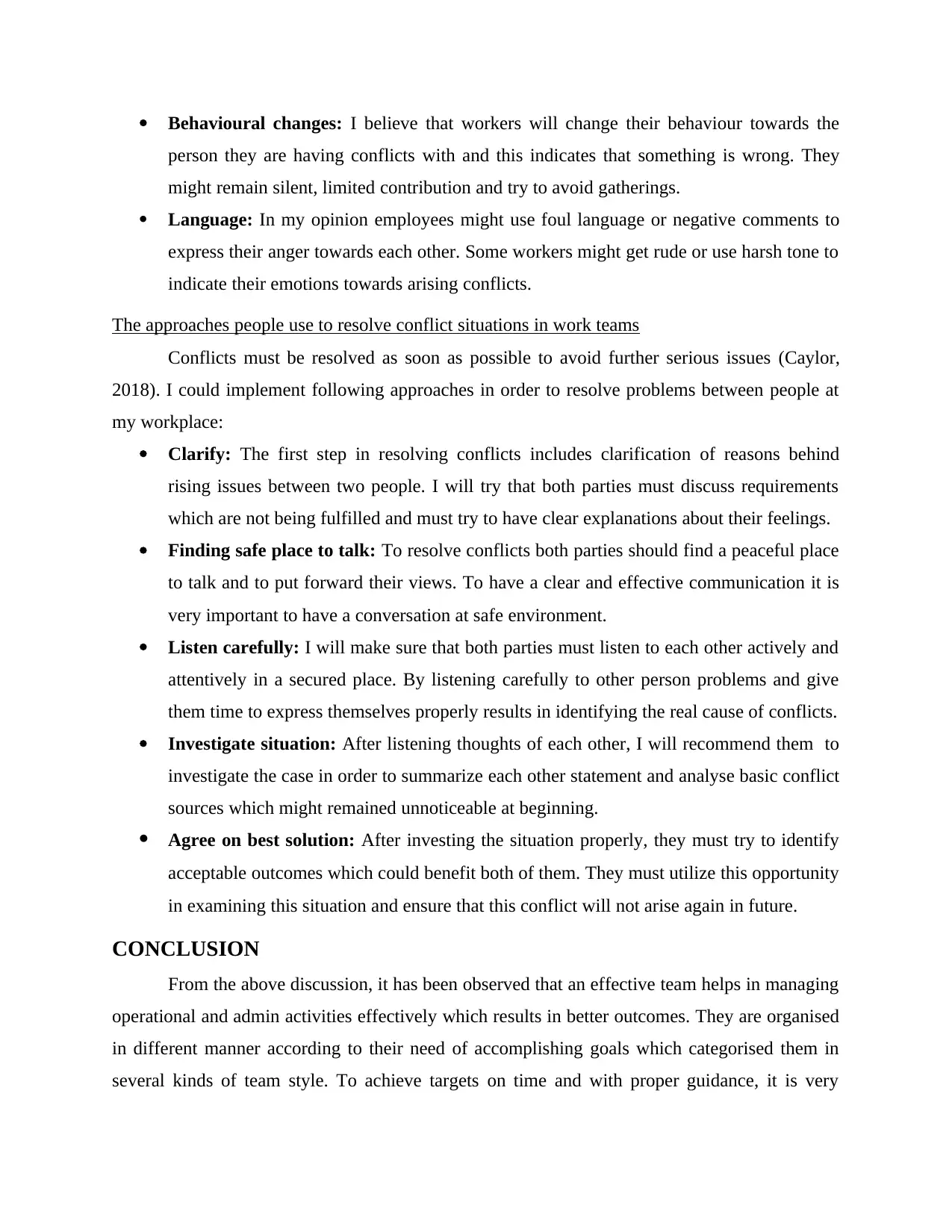
Behavioural changes: I believe that workers will change their behaviour towards the
person they are having conflicts with and this indicates that something is wrong. They
might remain silent, limited contribution and try to avoid gatherings.
Language: In my opinion employees might use foul language or negative comments to
express their anger towards each other. Some workers might get rude or use harsh tone to
indicate their emotions towards arising conflicts.
The approaches people use to resolve conflict situations in work teams
Conflicts must be resolved as soon as possible to avoid further serious issues (Caylor,
2018). I could implement following approaches in order to resolve problems between people at
my workplace:
Clarify: The first step in resolving conflicts includes clarification of reasons behind
rising issues between two people. I will try that both parties must discuss requirements
which are not being fulfilled and must try to have clear explanations about their feelings.
Finding safe place to talk: To resolve conflicts both parties should find a peaceful place
to talk and to put forward their views. To have a clear and effective communication it is
very important to have a conversation at safe environment.
Listen carefully: I will make sure that both parties must listen to each other actively and
attentively in a secured place. By listening carefully to other person problems and give
them time to express themselves properly results in identifying the real cause of conflicts.
Investigate situation: After listening thoughts of each other, I will recommend them to
investigate the case in order to summarize each other statement and analyse basic conflict
sources which might remained unnoticeable at beginning.
Agree on best solution: After investing the situation properly, they must try to identify
acceptable outcomes which could benefit both of them. They must utilize this opportunity
in examining this situation and ensure that this conflict will not arise again in future.
CONCLUSION
From the above discussion, it has been observed that an effective team helps in managing
operational and admin activities effectively which results in better outcomes. They are organised
in different manner according to their need of accomplishing goals which categorised them in
several kinds of team style. To achieve targets on time and with proper guidance, it is very
person they are having conflicts with and this indicates that something is wrong. They
might remain silent, limited contribution and try to avoid gatherings.
Language: In my opinion employees might use foul language or negative comments to
express their anger towards each other. Some workers might get rude or use harsh tone to
indicate their emotions towards arising conflicts.
The approaches people use to resolve conflict situations in work teams
Conflicts must be resolved as soon as possible to avoid further serious issues (Caylor,
2018). I could implement following approaches in order to resolve problems between people at
my workplace:
Clarify: The first step in resolving conflicts includes clarification of reasons behind
rising issues between two people. I will try that both parties must discuss requirements
which are not being fulfilled and must try to have clear explanations about their feelings.
Finding safe place to talk: To resolve conflicts both parties should find a peaceful place
to talk and to put forward their views. To have a clear and effective communication it is
very important to have a conversation at safe environment.
Listen carefully: I will make sure that both parties must listen to each other actively and
attentively in a secured place. By listening carefully to other person problems and give
them time to express themselves properly results in identifying the real cause of conflicts.
Investigate situation: After listening thoughts of each other, I will recommend them to
investigate the case in order to summarize each other statement and analyse basic conflict
sources which might remained unnoticeable at beginning.
Agree on best solution: After investing the situation properly, they must try to identify
acceptable outcomes which could benefit both of them. They must utilize this opportunity
in examining this situation and ensure that this conflict will not arise again in future.
CONCLUSION
From the above discussion, it has been observed that an effective team helps in managing
operational and admin activities effectively which results in better outcomes. They are organised
in different manner according to their need of accomplishing goals which categorised them in
several kinds of team style. To achieve targets on time and with proper guidance, it is very
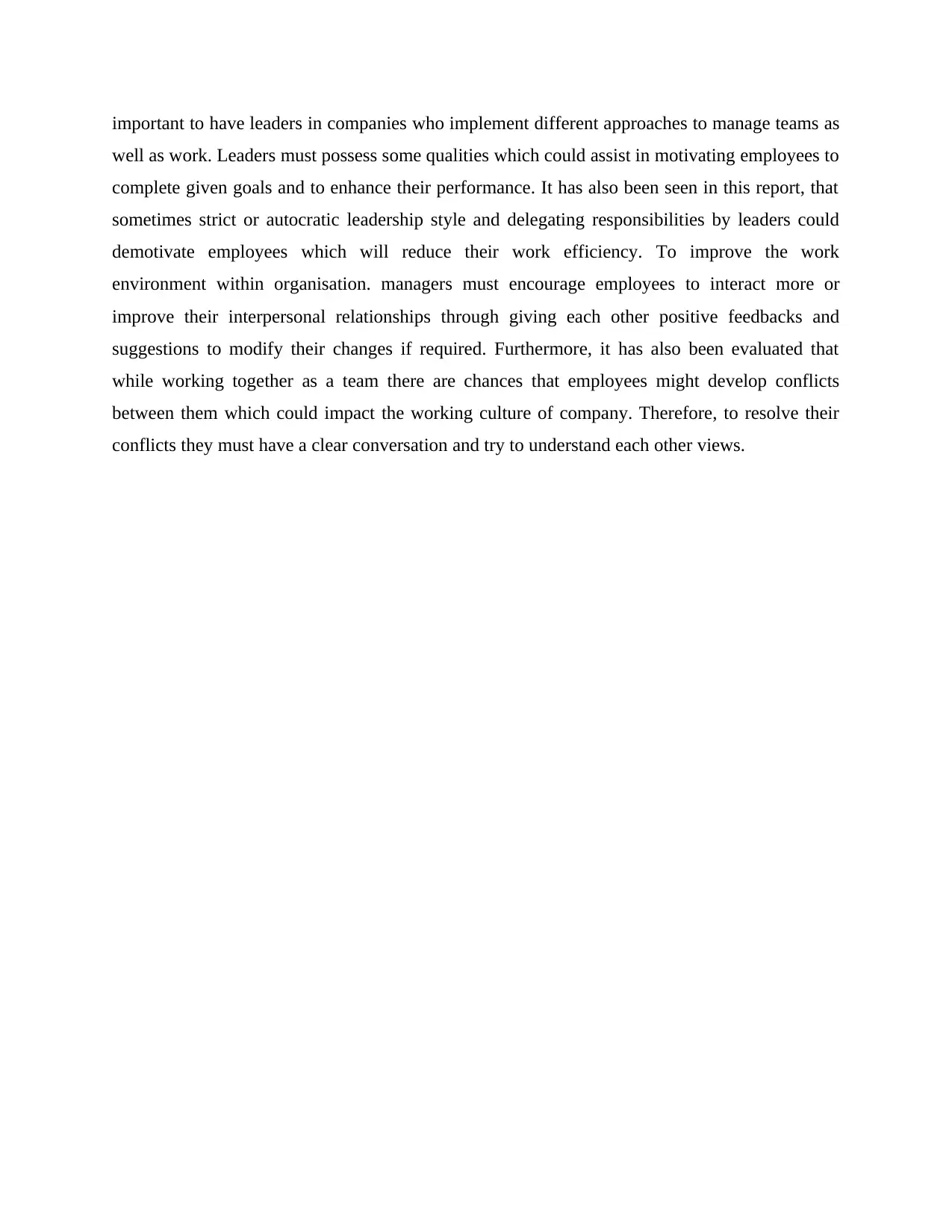
important to have leaders in companies who implement different approaches to manage teams as
well as work. Leaders must possess some qualities which could assist in motivating employees to
complete given goals and to enhance their performance. It has also been seen in this report, that
sometimes strict or autocratic leadership style and delegating responsibilities by leaders could
demotivate employees which will reduce their work efficiency. To improve the work
environment within organisation. managers must encourage employees to interact more or
improve their interpersonal relationships through giving each other positive feedbacks and
suggestions to modify their changes if required. Furthermore, it has also been evaluated that
while working together as a team there are chances that employees might develop conflicts
between them which could impact the working culture of company. Therefore, to resolve their
conflicts they must have a clear conversation and try to understand each other views.
well as work. Leaders must possess some qualities which could assist in motivating employees to
complete given goals and to enhance their performance. It has also been seen in this report, that
sometimes strict or autocratic leadership style and delegating responsibilities by leaders could
demotivate employees which will reduce their work efficiency. To improve the work
environment within organisation. managers must encourage employees to interact more or
improve their interpersonal relationships through giving each other positive feedbacks and
suggestions to modify their changes if required. Furthermore, it has also been evaluated that
while working together as a team there are chances that employees might develop conflicts
between them which could impact the working culture of company. Therefore, to resolve their
conflicts they must have a clear conversation and try to understand each other views.
Secure Best Marks with AI Grader
Need help grading? Try our AI Grader for instant feedback on your assignments.
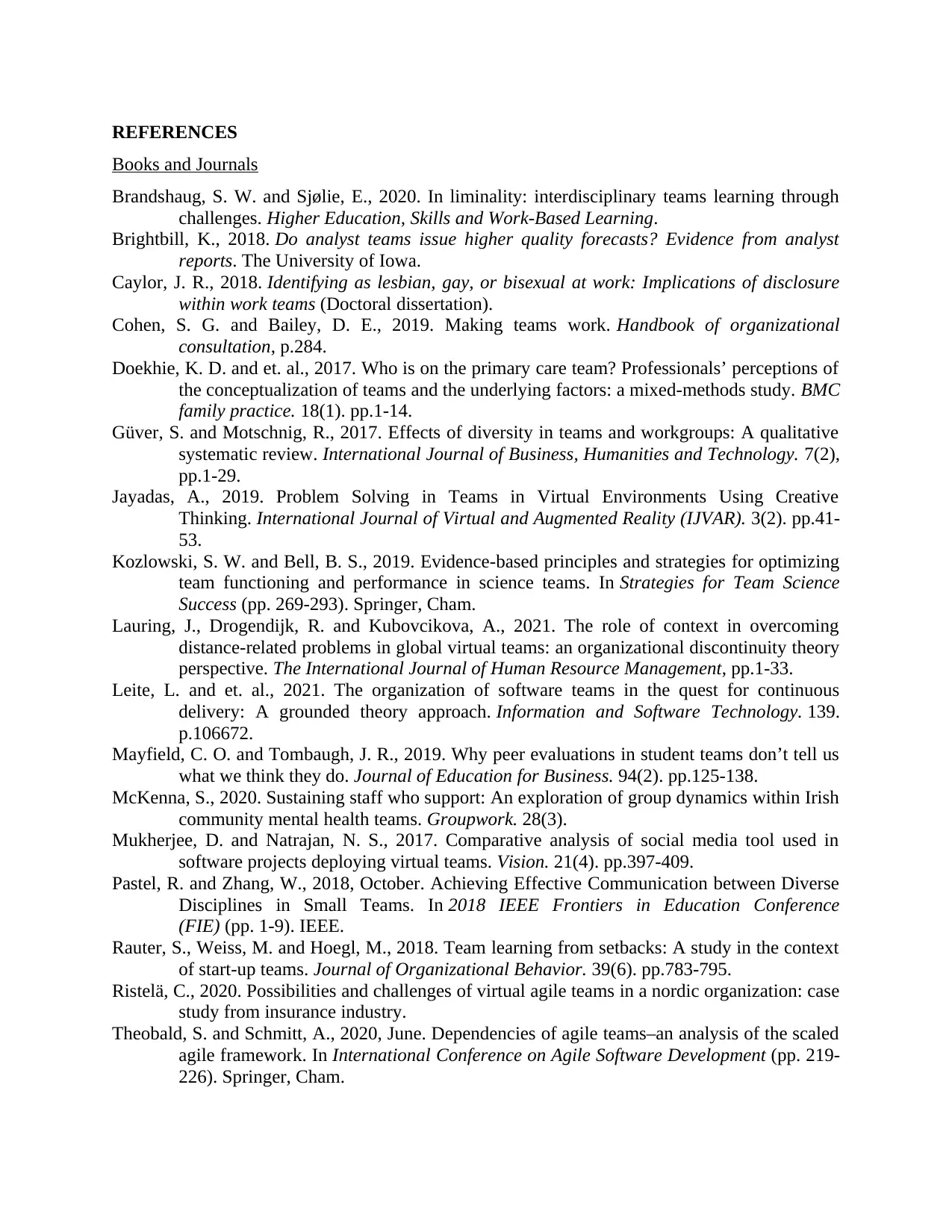
REFERENCES
Books and Journals
Brandshaug, S. W. and Sjølie, E., 2020. In liminality: interdisciplinary teams learning through
challenges. Higher Education, Skills and Work-Based Learning.
Brightbill, K., 2018. Do analyst teams issue higher quality forecasts? Evidence from analyst
reports. The University of Iowa.
Caylor, J. R., 2018. Identifying as lesbian, gay, or bisexual at work: Implications of disclosure
within work teams (Doctoral dissertation).
Cohen, S. G. and Bailey, D. E., 2019. Making teams work. Handbook of organizational
consultation, p.284.
Doekhie, K. D. and et. al., 2017. Who is on the primary care team? Professionals’ perceptions of
the conceptualization of teams and the underlying factors: a mixed-methods study. BMC
family practice. 18(1). pp.1-14.
Güver, S. and Motschnig, R., 2017. Effects of diversity in teams and workgroups: A qualitative
systematic review. International Journal of Business, Humanities and Technology. 7(2),
pp.1-29.
Jayadas, A., 2019. Problem Solving in Teams in Virtual Environments Using Creative
Thinking. International Journal of Virtual and Augmented Reality (IJVAR). 3(2). pp.41-
53.
Kozlowski, S. W. and Bell, B. S., 2019. Evidence-based principles and strategies for optimizing
team functioning and performance in science teams. In Strategies for Team Science
Success (pp. 269-293). Springer, Cham.
Lauring, J., Drogendijk, R. and Kubovcikova, A., 2021. The role of context in overcoming
distance-related problems in global virtual teams: an organizational discontinuity theory
perspective. The International Journal of Human Resource Management, pp.1-33.
Leite, L. and et. al., 2021. The organization of software teams in the quest for continuous
delivery: A grounded theory approach. Information and Software Technology. 139.
p.106672.
Mayfield, C. O. and Tombaugh, J. R., 2019. Why peer evaluations in student teams don’t tell us
what we think they do. Journal of Education for Business. 94(2). pp.125-138.
McKenna, S., 2020. Sustaining staff who support: An exploration of group dynamics within Irish
community mental health teams. Groupwork. 28(3).
Mukherjee, D. and Natrajan, N. S., 2017. Comparative analysis of social media tool used in
software projects deploying virtual teams. Vision. 21(4). pp.397-409.
Pastel, R. and Zhang, W., 2018, October. Achieving Effective Communication between Diverse
Disciplines in Small Teams. In 2018 IEEE Frontiers in Education Conference
(FIE) (pp. 1-9). IEEE.
Rauter, S., Weiss, M. and Hoegl, M., 2018. Team learning from setbacks: A study in the context
of start‐up teams. Journal of Organizational Behavior. 39(6). pp.783-795.
Ristelä, C., 2020. Possibilities and challenges of virtual agile teams in a nordic organization: case
study from insurance industry.
Theobald, S. and Schmitt, A., 2020, June. Dependencies of agile teams–an analysis of the scaled
agile framework. In International Conference on Agile Software Development (pp. 219-
226). Springer, Cham.
Books and Journals
Brandshaug, S. W. and Sjølie, E., 2020. In liminality: interdisciplinary teams learning through
challenges. Higher Education, Skills and Work-Based Learning.
Brightbill, K., 2018. Do analyst teams issue higher quality forecasts? Evidence from analyst
reports. The University of Iowa.
Caylor, J. R., 2018. Identifying as lesbian, gay, or bisexual at work: Implications of disclosure
within work teams (Doctoral dissertation).
Cohen, S. G. and Bailey, D. E., 2019. Making teams work. Handbook of organizational
consultation, p.284.
Doekhie, K. D. and et. al., 2017. Who is on the primary care team? Professionals’ perceptions of
the conceptualization of teams and the underlying factors: a mixed-methods study. BMC
family practice. 18(1). pp.1-14.
Güver, S. and Motschnig, R., 2017. Effects of diversity in teams and workgroups: A qualitative
systematic review. International Journal of Business, Humanities and Technology. 7(2),
pp.1-29.
Jayadas, A., 2019. Problem Solving in Teams in Virtual Environments Using Creative
Thinking. International Journal of Virtual and Augmented Reality (IJVAR). 3(2). pp.41-
53.
Kozlowski, S. W. and Bell, B. S., 2019. Evidence-based principles and strategies for optimizing
team functioning and performance in science teams. In Strategies for Team Science
Success (pp. 269-293). Springer, Cham.
Lauring, J., Drogendijk, R. and Kubovcikova, A., 2021. The role of context in overcoming
distance-related problems in global virtual teams: an organizational discontinuity theory
perspective. The International Journal of Human Resource Management, pp.1-33.
Leite, L. and et. al., 2021. The organization of software teams in the quest for continuous
delivery: A grounded theory approach. Information and Software Technology. 139.
p.106672.
Mayfield, C. O. and Tombaugh, J. R., 2019. Why peer evaluations in student teams don’t tell us
what we think they do. Journal of Education for Business. 94(2). pp.125-138.
McKenna, S., 2020. Sustaining staff who support: An exploration of group dynamics within Irish
community mental health teams. Groupwork. 28(3).
Mukherjee, D. and Natrajan, N. S., 2017. Comparative analysis of social media tool used in
software projects deploying virtual teams. Vision. 21(4). pp.397-409.
Pastel, R. and Zhang, W., 2018, October. Achieving Effective Communication between Diverse
Disciplines in Small Teams. In 2018 IEEE Frontiers in Education Conference
(FIE) (pp. 1-9). IEEE.
Rauter, S., Weiss, M. and Hoegl, M., 2018. Team learning from setbacks: A study in the context
of start‐up teams. Journal of Organizational Behavior. 39(6). pp.783-795.
Ristelä, C., 2020. Possibilities and challenges of virtual agile teams in a nordic organization: case
study from insurance industry.
Theobald, S. and Schmitt, A., 2020, June. Dependencies of agile teams–an analysis of the scaled
agile framework. In International Conference on Agile Software Development (pp. 219-
226). Springer, Cham.
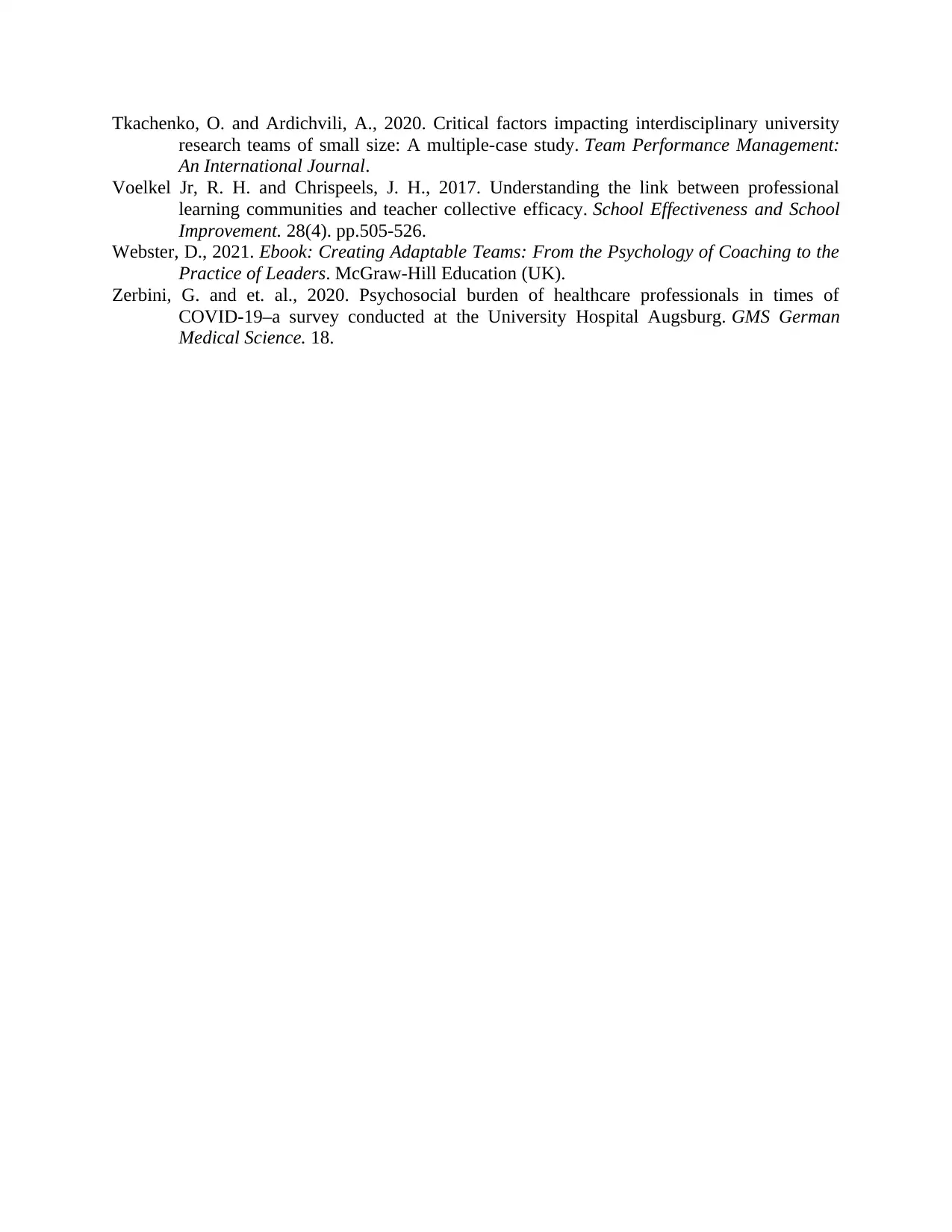
Tkachenko, O. and Ardichvili, A., 2020. Critical factors impacting interdisciplinary university
research teams of small size: A multiple-case study. Team Performance Management:
An International Journal.
Voelkel Jr, R. H. and Chrispeels, J. H., 2017. Understanding the link between professional
learning communities and teacher collective efficacy. School Effectiveness and School
Improvement. 28(4). pp.505-526.
Webster, D., 2021. Ebook: Creating Adaptable Teams: From the Psychology of Coaching to the
Practice of Leaders. McGraw-Hill Education (UK).
Zerbini, G. and et. al., 2020. Psychosocial burden of healthcare professionals in times of
COVID-19–a survey conducted at the University Hospital Augsburg. GMS German
Medical Science. 18.
research teams of small size: A multiple-case study. Team Performance Management:
An International Journal.
Voelkel Jr, R. H. and Chrispeels, J. H., 2017. Understanding the link between professional
learning communities and teacher collective efficacy. School Effectiveness and School
Improvement. 28(4). pp.505-526.
Webster, D., 2021. Ebook: Creating Adaptable Teams: From the Psychology of Coaching to the
Practice of Leaders. McGraw-Hill Education (UK).
Zerbini, G. and et. al., 2020. Psychosocial burden of healthcare professionals in times of
COVID-19–a survey conducted at the University Hospital Augsburg. GMS German
Medical Science. 18.
1 out of 12
Related Documents
Your All-in-One AI-Powered Toolkit for Academic Success.
+13062052269
info@desklib.com
Available 24*7 on WhatsApp / Email
![[object Object]](/_next/static/media/star-bottom.7253800d.svg)
Unlock your academic potential
© 2024 | Zucol Services PVT LTD | All rights reserved.





